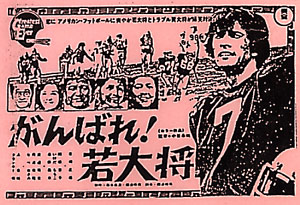 The "Young Guy" or "yangu gai" series never really entertained me. I saw a few episodes back in the '70s & early '80s only because they were on double-bills with other films I did want to see.
The "Young Guy" or "yangu gai" series never really entertained me. I saw a few episodes back in the '70s & early '80s only because they were on double-bills with other films I did want to see.
These were seishun-eiga or youth films, & though I would not say they were as stinko as Beach Blanket Bingo (1965) type films in America, that's the leaning.
The first episode I ever sat through was Ganbare! Wakadaisho (1975) generally known in English as Go For It! Young Guy though the subtitled print I saw bore the title Greatest Game Ever.
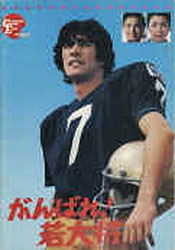 This comedy set against a backdrop of college sports starred Masao Kusakiri as the "young guy" football hero, with comedian Frankie Sakai co-starring, & Keiko Sekine (later Keiko Takahashi) as the young guy's love interest. This comedy set against a backdrop of college sports starred Masao Kusakiri as the "young guy" football hero, with comedian Frankie Sakai co-starring, & Keiko Sekine (later Keiko Takahashi) as the young guy's love interest.
There was one sequel starring Masao Kusakiri, Gekitotsu Wakadaisho (Clash! You Guy, 1976), but the public apparently didn't take to Kusakiri in the role, & he never contributed a third feature film to the long running series, though he was to remain a popular star especially in television taiga dramas, & he's well enough known in the west for roles in films from the justly lionized director Shohei Imamura.
The director on those two films had been one of the last of a handful of directors who'd done earlier episodes all starring Yuzo Kayama as young guy Yuichi Tanuma, & instead of Frankie Sakai, Kunie Tanaka played his comparatively goofy best friend Ao Daisho. Kusakiri played the young guy with something of a shaggy hippy haircut for the '70s, but Kayama was invariably clean-cut & collegiate.
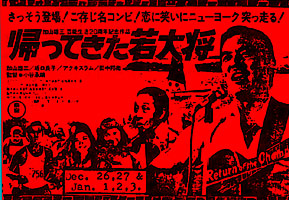 Kayama was just getting too on in years to pull it off, since he'd been playing the college-football hotshot since Daigaku no wakadaisho (Bull of the Campus; aka, University Young Guy; or, Sir Galahad in Campus, 1961), with water-skiing the excuse to get him to show a lot of skin. Kayama was just getting too on in years to pull it off, since he'd been playing the college-football hotshot since Daigaku no wakadaisho (Bull of the Campus; aka, University Young Guy; or, Sir Galahad in Campus, 1961), with water-skiing the excuse to get him to show a lot of skin.
The series would make him one of Japan's biggest stars, & he kept pace as a recording artist as well. He occasionally made serious films, including starring role opposite Toshiro Mifune in Akira Kurosawa's Red Beard (Akehage, 1965); opposite Tatsuya Nakadai in Sword of Doom (Daibosatsu toge, 1966); & a few other suchlike.
He played the role of Yuichi Tanuma through 1970, then after Takahashi failed to recharge the series in '75/76, Kayama returned one last time to reprise the role in Kaettekita wakadaisho (1981), This one's usually given in English as Young Guy Returns although the subtitled print I saw bore the title Return of the Champ. The director was the same Shusei Kotani who'd tried to restart the series with Masao Kusakiri.
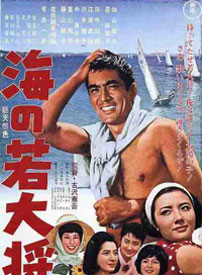 In this last hurrah for our by-no-means-still-young Young Guy, Yuichi Tanuma & Ao Daisho are businessmen (they had to grow up someday) who end up in New York city on business. In this last hurrah for our by-no-means-still-young Young Guy, Yuichi Tanuma & Ao Daisho are businessmen (they had to grow up someday) who end up in New York city on business.
Our athletic hero entering a marathon upon which the future independence of the Southern Cross Islands on the line (from the Japanese point of view, being a US Protectorate is the same as military Occupation, hence a bad thing).
The rest of the series will be listed, with a few briefly discussed, in order of their release:
Ginza no wakadaisho (Pride of the Campus; aka, Young Guy in Ginza, 1962) showing our buff lad as a boxer, mountain skier, & cook; Nihon ichi no wakadaisho (Japan's Number One Young Guy, 1962) with our buff lad at the beach; Hawaii no wakadaisho (Young Guy in Hawaii, 1963) once again showing lots of skin at the beach; & Umi no wakadaisho (Young Guy at Sea, 1965) with sailing becoming the young guy's sport.
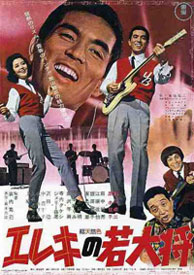 These were followed by probably the most important episode, Ereki no wakadaisho (Campus A-Go-Go; aka, Electric Guitar Young Guy, 1965). This was not the only episode to make a rockin' guitar hero out of the star, who would remain a popular guitar performer even after his film career wound down. These were followed by probably the most important episode, Ereki no wakadaisho (Campus A-Go-Go; aka, Electric Guitar Young Guy, 1965). This was not the only episode to make a rockin' guitar hero out of the star, who would remain a popular guitar performer even after his film career wound down.
The "Ereki" guitar had made the same impact on Japanese youth for the 1960s that it had made beginning in the late 1950s in America.
Between 1962 & early '65, an American instrumental rock band from the Pacific Northwest, The Ventures, made an incredible impact during their regular Japanese tours. By '64 the Ventures were being mobbed at airports & teenagers blocked interesections winding around blocks of venues featuring the Ventures.
Their 1965 tour & the Japanese youth response can be appreciated through the Hiroshima concert film Beloved Invaders: The Ventures (1966) mixes a lot of live concert footage with a little of their encounters with their fans & their experience of Japanese culture or touristy stuff. There's almost no talking, being all but nonstop music. But when they do talk, they've been dubbed into Japanese!
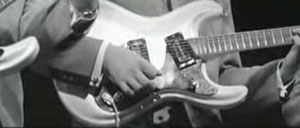 The quality of the sound recording is superb, & the black & white widescreen footage gorgeous to look at. The quality of the sound recording is superb, & the black & white widescreen footage gorgeous to look at.
Black & white cinemascope was a commonplace in Japanese cinema of the time, but unusual for an American-directed documentary or concert film. This one, however, had an all-Japanese crew supporting the director, resulting in something visually pleasing.
These four guys are very funny when they want to be, but the main thing is that Beloved Invaders constitutes a perfection of guitar-rock musicianship performed live, without need of studio-mix to be just outrageously grand.
We get many of their most familiar hits, including "Telstar," "Walk Don't Run," "Apache," "Wipe Out," "Diamond Head," "Slaughter on Tenth Avenue" & closing with an extended version of "Caravan" to die for).
There's stuff I'd either forgotten ("The Cruel Sea") or never heard before that's just as awesome. My mouth dropped open in amazement of their instrumental arrangement of "House of the Rising Sun."
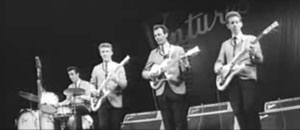 There are a few of their hits they don't do, including "Lolita Ya Ya" which might've been great to hear with Japanese girls doing the "Ya Ya Wah-ah Wah-ah Ya Ya" bits. There are a few of their hits they don't do, including "Lolita Ya Ya" which might've been great to hear with Japanese girls doing the "Ya Ya Wah-ah Wah-ah Ya Ya" bits.
Also missing are "Sleep Walk," "Perfidia," & "Out of Limits" I'd've loved to have heard included. But it's cool they did have so many hits by '65 it wasn't possible to do every single one.
That these three guitarists & a drummer outsold the Beatles in Japan makes perfect sense when you actually see the Ventures performing live; the only question is why they didn't outsell the Beatles everywhere else in the world!
The Ventures continue into the new millenium to do Japanese concerts, & as senior citizens still draw youth crowds. But back there in '64/65 they instigated the "Ereki Buumu" or "electric guitar boom" that meant every teenager wanted to start an "ereki" or "electric" rock band or at least a duo.
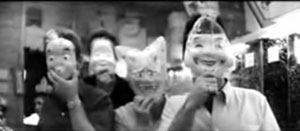 The Wakadaisho films were heavily impacted by this explosive guitar culture. The Wakadaisho films were heavily impacted by this explosive guitar culture.
Yuzo became good friends with the Ventures' band members & learned to play guitar very close to the so-called "surf" style (though the Ventures were from Tacoma, Washington, where surf culture did not exist).
And while in America completely phony pretend-rock-stars like Fabian or Anette Funacello were fobbed off in youth-films with little or no musical value, Kayama's devotion to the sound of the Ventures meant his Wakadaisho films whatever the attendant faults occasionally transcended pop-rock cinema standards.
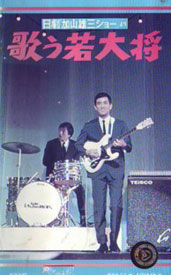 Yuzo's live stage presence as a singer & guitarist can be experienced in the concert film Nichigeki Kayama Yuzo sho yori: utau wakadaisho (From the Theatrical Show of Yuzo Kayama Show: The Young Guy Sings, 1966). He appears with his back-up band the Launchers singing & playing numbers from the Young Guy series. Yuzo's live stage presence as a singer & guitarist can be experienced in the concert film Nichigeki Kayama Yuzo sho yori: utau wakadaisho (From the Theatrical Show of Yuzo Kayama Show: The Young Guy Sings, 1966). He appears with his back-up band the Launchers singing & playing numbers from the Young Guy series.
Kayama together with Takeshi Terauchi became Japan's first two native-born guitar heroes, with enough of the Ventures in them that they're really quite good.
In a wonderfully mutual homage, two hit songs performed by Terauchi & Kayama which came out of Ereki no wakadaisho -- namely "Yozoro no Hoshi" ("Stars in the Night Sky") & "Kimi to Itsu Made mo" ("With You Forever") -- became a permanent part of the Ventures' repertoire, too!
Ereki no wakadaisho focuses on a "battle of the bands" scenario with our sports-oriented Young Guy adapting rock 'n' roll as his new "sport," with his band The Launchers doing their actual pop hits.
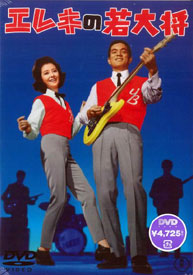 Most of the Wakadaisho films probably would not appeal to international audiences unless as pop culture studies, though if people can still stand Gidget or Beach films there's no reason Wakadaisho wouldn't have the same appeal. Most of the Wakadaisho films probably would not appeal to international audiences unless as pop culture studies, though if people can still stand Gidget or Beach films there's no reason Wakadaisho wouldn't have the same appeal.
But Eleki no wakadaisho in particular would be a great side-feature for a mini-festival of films revealing the world-wide influence of the Ventures, the Beatles, & of British & American "Go-Go" dance scene & fashion. There's even a girl-band in go-go boots who were ahead of their time, reminiscent of punk-rock still on the horizon.
The series continued with Arupusu no wakadaisho (It Started in the Alps, 1966); Retsu go! Wakadaisho (Let's Go! Young Guy, 1967) with Young Guy skiing the slopes; & Minami taiheiyo no wakadaisho (Judo Champion; aka, Young Guy in the South Pacific, 1967) with our all-purpose sports hero pursuing martial arts & skin-diving.
Further episodes were Go! Go! Wakadaisho (Go! Go! Young Guy; aka, Skiing on the Summit, 1967) again making a ski-bum of wakadaisho; Rio no wakadaisho (Young Guy in Rio, 1968) putting our buff hero on a surf board; Furesshuman wakadaisho (Freshman Young Guy; aka, Young Guy Graduates, 1969) introducing our maturing hero to the busienss world; & Nyu jirando no wakadaisho (Young Guy in New Zealand; aka, Young Guy on Mount Cook, 1969) taking our sportsman from ocean shores to mountain heights.
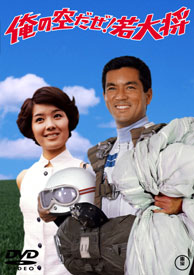 The series went into the next decade with Burabo! Wakadaisho (Bravo! Young Guy, 1970) making Young Guy a deep sea fisherman; Ore no sora da ze! Wakadaisho (It's My Sky! Young Guy, 1970) with the young guy's sport this time sky-diving; & Wakadaisho tai Aodaisho (Young Guy vs. Blue Guy, 1971) putting our young guy on a motorcycle. The series went into the next decade with Burabo! Wakadaisho (Bravo! Young Guy, 1970) making Young Guy a deep sea fisherman; Ore no sora da ze! Wakadaisho (It's My Sky! Young Guy, 1970) with the young guy's sport this time sky-diving; & Wakadaisho tai Aodaisho (Young Guy vs. Blue Guy, 1971) putting our young guy on a motorcycle.
Then as already discussed there followed the two episodes in '75 & '76 with a replacement-star whom the public didn't want in this role, & lastly the '81 episode bringing back Kayama for a final farwell to the character.
The dvds singly or in sets are not subtitled. Five of the early episodes are available in a limited edition boxed set as Wakadaisho Campus. Six later episodes (including the 1981 "return") are available as a limited edition boxed set as Wakadaisho Freshman.
The old 35 mm subtitled prints formerly distributed to North American ethnic theaters in Hawaii, San Francisco, Seattle, Vancouver, Toronto, & New York ended up in the University of Chicago East Asia film library after the video era brought about the demise of the Japanese cinema houses, & can be obtained for revivals but only on non-profit screens. University of Chicago has all the Yuzo Kayama Wakadaisho episodes, & even his concert film, misfiled under an abbreviated title Utao Wakadaisho so don't let'm tell ya they can't find it.
copyright © by Paghat the Ratgirl
|


 This comedy set against a backdrop of college sports starred Masao Kusakiri as the "young guy" football hero, with comedian Frankie Sakai co-starring, & Keiko Sekine (later Keiko Takahashi) as the young guy's love interest.
This comedy set against a backdrop of college sports starred Masao Kusakiri as the "young guy" football hero, with comedian Frankie Sakai co-starring, & Keiko Sekine (later Keiko Takahashi) as the young guy's love interest. Kayama was just getting too on in years to pull it off, since he'd been playing the college-football hotshot since Daigaku no wakadaisho (Bull of the Campus; aka, University Young Guy; or, Sir Galahad in Campus, 1961), with water-skiing the excuse to get him to show a lot of skin.
Kayama was just getting too on in years to pull it off, since he'd been playing the college-football hotshot since Daigaku no wakadaisho (Bull of the Campus; aka, University Young Guy; or, Sir Galahad in Campus, 1961), with water-skiing the excuse to get him to show a lot of skin. In this last hurrah for our by-no-means-still-young Young Guy, Yuichi Tanuma & Ao Daisho are businessmen (they had to grow up someday) who end up in New York city on business.
In this last hurrah for our by-no-means-still-young Young Guy, Yuichi Tanuma & Ao Daisho are businessmen (they had to grow up someday) who end up in New York city on business. These were followed by probably the most important episode, Ereki no wakadaisho (Campus A-Go-Go; aka, Electric Guitar Young Guy, 1965). This was not the only episode to make a rockin' guitar hero out of the star, who would remain a popular guitar performer even after his film career wound down.
These were followed by probably the most important episode, Ereki no wakadaisho (Campus A-Go-Go; aka, Electric Guitar Young Guy, 1965). This was not the only episode to make a rockin' guitar hero out of the star, who would remain a popular guitar performer even after his film career wound down. The quality of the sound recording is superb, & the black & white widescreen footage gorgeous to look at.
The quality of the sound recording is superb, & the black & white widescreen footage gorgeous to look at. There are a few of their hits they don't do, including "Lolita Ya Ya" which might've been great to hear with Japanese girls doing the "Ya Ya Wah-ah Wah-ah Ya Ya" bits.
There are a few of their hits they don't do, including "Lolita Ya Ya" which might've been great to hear with Japanese girls doing the "Ya Ya Wah-ah Wah-ah Ya Ya" bits. The Wakadaisho films were heavily impacted by this explosive guitar culture.
The Wakadaisho films were heavily impacted by this explosive guitar culture. Yuzo's live stage presence as a singer & guitarist can be experienced in the concert film Nichigeki Kayama Yuzo sho yori: utau wakadaisho (From the Theatrical Show of Yuzo Kayama Show: The Young Guy Sings, 1966). He appears with his back-up band the Launchers singing & playing numbers from the Young Guy series.
Yuzo's live stage presence as a singer & guitarist can be experienced in the concert film Nichigeki Kayama Yuzo sho yori: utau wakadaisho (From the Theatrical Show of Yuzo Kayama Show: The Young Guy Sings, 1966). He appears with his back-up band the Launchers singing & playing numbers from the Young Guy series. Most of the Wakadaisho films probably would not appeal to international audiences unless as pop culture studies, though if people can still stand Gidget or Beach films there's no reason Wakadaisho wouldn't have the same appeal.
Most of the Wakadaisho films probably would not appeal to international audiences unless as pop culture studies, though if people can still stand Gidget or Beach films there's no reason Wakadaisho wouldn't have the same appeal. The series went into the next decade with Burabo! Wakadaisho (Bravo! Young Guy, 1970) making Young Guy a deep sea fisherman; Ore no sora da ze! Wakadaisho (It's My Sky! Young Guy, 1970) with the young guy's sport this time sky-diving; & Wakadaisho tai Aodaisho (Young Guy vs. Blue Guy, 1971) putting our young guy on a motorcycle.
The series went into the next decade with Burabo! Wakadaisho (Bravo! Young Guy, 1970) making Young Guy a deep sea fisherman; Ore no sora da ze! Wakadaisho (It's My Sky! Young Guy, 1970) with the young guy's sport this time sky-diving; & Wakadaisho tai Aodaisho (Young Guy vs. Blue Guy, 1971) putting our young guy on a motorcycle.